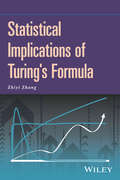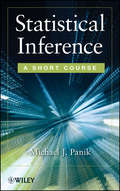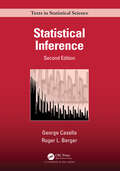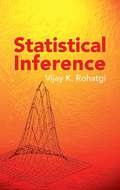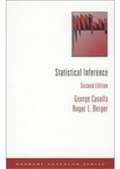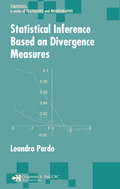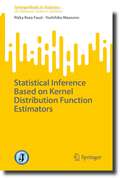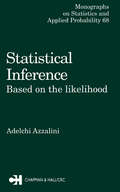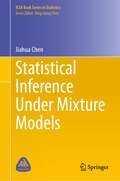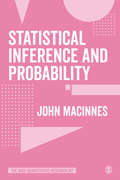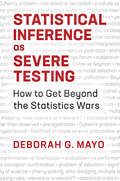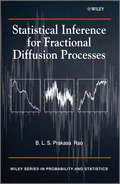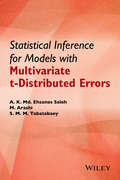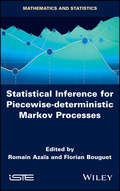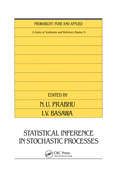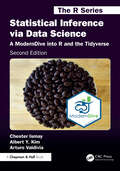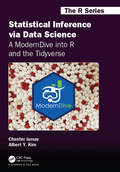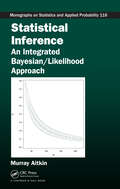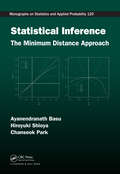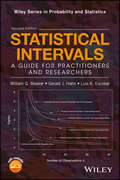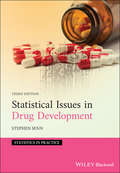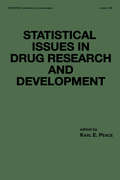- Table View
- List View
Statistical Implications of Turing's Formula
by Zhiyi ZhangFeatures a broad introduction to recent research on Turing's formula and presents modern applications in statistics, probability, information theory, and other areas of modern data science Turing's formula is, perhaps, the only known method for estimating the underlying distributional characteristics beyond the range of observed data without making any parametric or semiparametric assumptions. This book presents a clear introduction to Turing's formula and its connections to statistics. Topics with relevance to a variety of different fields of study are included such as information theory; statistics; probability; computer science inclusive of artificial intelligence and machine learning; big data; biology; ecology; and genetics. The author provides examinations of many core statistical issues within modern data science from Turing's perspective. A systematic approach to long-standing problems such as entropy and mutual information estimation, diversity index estimation, domains of attraction on general alphabets, and tail probability estimation is presented in light of the most up-to-date understanding of Turing's formula. Featuring numerous exercises and examples throughout, the author provides a summary of the known properties of Turing's formula and explains how and when it works well; discusses the approach derived from Turing's formula in order to estimate a variety of quantities, all of which mainly come from information theory, but are also important for machine learning and for ecological applications; and uses Turing's formula to estimate certain heavy-tailed distributions. In summary, this book: * Features a unified and broad presentation of Turing's formula, including its connections to statistics, probability, information theory, and other areas of modern data science * Provides a presentation on the statistical estimation of information theoretic quantities * Demonstrates the estimation problems of several statistical functions from Turing's perspective such as Simpson's indices, Shannon's entropy, general diversity indices, mutual information, and Kullback-Leibler divergence * Includes numerous exercises and examples throughout with a fundamental perspective on the key results of Turing's formula Statistical Implications of Turing's Formula is an ideal reference for researchers and practitioners who need a review of the many critical statistical issues of modern data science. This book is also an appropriate learning resource for biologists, ecologists, and geneticists who are involved with the concept of diversity and its estimation and can be used as a textbook for graduate courses in mathematics, probability, statistics, computer science, artificial intelligence, machine learning, big data, and information theory. Zhiyi Zhang, PhD, is Professor of Mathematics and Statistics at The University of North Carolina at Charlotte. He is an active consultant in both industry and government on a wide range of statistical issues, and his current research interests include Turing's formula and its statistical implications; probability and statistics on countable alphabets; nonparametric estimation of entropy and mutual information; tail probability and biodiversity indices; and applications involving extracting statistical information from low-frequency data space. He earned his PhD in Statistics from Rutgers University.
Statistical Inference
by Michael J. PanikA concise, easily accessible introduction to descriptive and inferential techniquesStatistical Inference: A Short Course offers a concise presentation of the essentials of basic statistics for readers seeking to acquire a working knowledge of statistical concepts, measures, and procedures.The author conducts tests on the assumption of randomness and normality, provides nonparametric methods when parametric approaches might not work. The book also explores how to determine a confidence interval for a population median while also providing coverage of ratio estimation, randomness, and causality. To ensure a thorough understanding of all key concepts, Statistical Inference provides numerous examples and solutions along with complete and precise answers to many fundamental questions, including:How do we determine that a given dataset is actually a random sample?With what level of precision and reliability can a population sample be estimated?How are probabilities determined and are they the same thing as odds?How can we predict the level of one variable from that of another?What is the strength of the relationship between two variables?The book is organized to present fundamental statistical concepts first, with later chapters exploring more advanced topics and additional statistical tests such as Distributional Hypotheses, Multinomial Chi-Square Statistics, and the Chi-Square Distribution. Each chapter includes appendices and exercises, allowing readers to test their comprehension of the presented material.Statistical Inference: A Short Course is an excellent book for courses on probability, mathematical statistics, and statistical inference at the upper-undergraduate and graduate levels. The book also serves as a valuable reference for researchers and practitioners who would like to develop further insights into essential statistical tools.
Statistical Inference (Chapman & Hall/CRC Texts in Statistical Science)
by George Casella Roger BergerThis classic textbook builds theoretical statistics from the first principles of probability theory. Starting from the basics of probability, the authors develop the theory of statistical inference using techniques, definitions, and concepts that are statistical and natural extensions, and consequences, of previous concepts. It covers all topics from a standard inference course including: distributions, random variables, data reduction, point estimation, hypothesis testing, and interval estimation. Features The classic graduate-level textbook on statistical inference Develops elements of statistical theory from first principles of probability Written in a lucid style accessible to anyone with some background in calculus Covers all key topics of a standard course in inference Hundreds of examples throughout to aid understanding Each chapter includes an extensive set of graduated exercises Statistical Inference, Second Edition is primarily aimed at graduate students of statistics, but can be used by advanced undergraduate students majoring in statistics who have a solid mathematics background. It also stresses the more practical uses of statistical theory, being more concerned with understanding basic statistical concepts and deriving reasonable statistical procedures, while less focused on formal optimality considerations.This is a reprint of the second edition originally published by Cengage Learning, Inc. in 2001.
Statistical Inference (Chapman And Hall/crc Monographs On Statistics And Applied Probability Ser. #7)
by S.D. SilveyStatistics is a subject with a vast field of application, involving problems which vary widely in their character and complexity.However, in tackling these, we use a relatively small core of central ideas and methods. This book attempts to concentrateattention on these ideas: they are placed in a general settingand illustrated by relatively simple examples, avoidingwherever possible the extraneous difficulties of complicatedmathematical manipulation.In order to compress the central body of ideas into a smallvolume, it is necessary to assume a fair degree of mathematicalsophistication on the part of the reader, and the book is intendedfor students of mathematics who are already accustomed tothinking in rather general terms about spaces and functions
Statistical Inference (Dover Books On Mathematics Ser.)
by Vijay K. RohatgiUnified treatment of probability and statistics examines and analyzes the relationship between the two fields, exploring inferential issues. Numerous problems, examples, and diagrams--some with solutions--plus clear-cut, highlighted summaries of results. Advanced undergraduate to graduate level. Contents: 1. Introduction. 2. Probability Model. 3. Probability Distributions. 4. Introduction to Statistical Inference. 5. More on Mathematical Expectation. 6. Some Discrete Models. 7. Some Continuous Models. 8. Functions of Random Variables and Random Vectors. 9. Large-Sample Theory. 10. General Methods of Point and Interval Estimation. 11. Testing Hypotheses. 12. Analysis of Categorical Data. 13. Analysis of Variance: k-Sample Problems. Appendix-Tables. Answers to Odd-Numbered Problems. Index. Unabridged republication of the edition published by John Wiley & Sons, New York, 1984. 144 Figures. 35 Tables. Errata list prepared by the author
Statistical Inference (Second Edition)
by George Casella Roger L. BergerThis book builds theoretical statistics from the first principles of probability theory. Starting from the basics of probability, the authors develop the theory of statistical inference using techniques, definitions, and concepts that are statistical and are natural extensions and consequences of previous concepts. Intended for first-year graduate students, this book can be used for students majoring in statistics who have a solid mathematics background. It can also be used in a way that stresses the more practical uses of statistical theory, being more concerned with understanding basic statistical concepts and deriving reasonable statistical procedures for a variety of situations, and less concerned with formal optimality investigations.
Statistical Inference Based on Divergence Measures (Statistics: A Series of Textbooks and Monographs)
by Leandro PardoThe idea of using functionals of Information Theory, such as entropies or divergences, in statistical inference is not new. However, in spite of the fact that divergence statistics have become a very good alternative to the classical likelihood ratio test and the Pearson-type statistic in discrete models, many statisticians remain unaware of this p
Statistical Inference Based on Kernel Distribution Function Estimators (SpringerBriefs in Statistics)
by Rizky Reza Fauzi Yoshihiko MaesonoThis book presents a study of statistical inferences based on the kernel-type estimators of distribution functions. The inferences involve matters such as quantile estimation, nonparametric tests, and mean residual life expectation, to name just some. Convergence rates for the kernel estimators of density functions are slower than ordinary parametric estimators, which have root-n consistency. If the appropriate kernel function is used, the kernel estimators of the distribution functions recover the root-n consistency, and the inferences based on kernel distribution estimators have root-n consistency. Further, the kernel-type estimator produces smooth estimation results. The estimators based on the empirical distribution function have discrete distribution, and the normal approximation cannot be improved—that is, the validity of the Edgeworth expansion cannot be proved. If the support of the population density function is bounded, there is a boundary problem, namely the estimator does not have consistency near the boundary. The book also contains a study of the mean squared errors of the estimators and the Edgeworth expansion for quantile estimators.
Statistical Inference Based on the likelihood (Monographs On Statistics And Applied Probability #Vol. 68)
by Adelchi AzzaliniThe Likelihood plays a key role in both introducing general notions of statistical theory, and in developing specific methods. This book introduces likelihood-based statistical theory and related methods from a classical viewpoint, and demonstrates how the main body of currently used statistical techniques can be generated from a few key concepts, in particular the likelihood.Focusing on those methods, which have both a solid theoretical background and practical relevance, the author gives formal justification of the methods used and provides numerical examples with real data.
Statistical Inference Under Mixture Models (ICSA Book Series in Statistics)
by Jiahua ChenThis book puts its weight on theoretical issues related to finite mixture models. It shows that a good applicant, is an applicant who understands the issues behind each statistical method. This book is intended for applicants whose interests include some understanding of the procedures they are using, while they do not have to read the technical derivations.At the same time, many researchers find most theories and techniques necessary for the development of various statistical methods, without chasing after one set of research papers, after another. Even though the book emphasizes the theory, it provides accessible numerical tools for data analysis. Readers with strength in developing statistical software, may find it useful.
Statistical Inference and Probability (The SAGE Quantitative Research Kit)
by John MacInnesAn experienced author in the field of data analytics and statistics, John Macinnes has produced a straight-forward text that breaks down the complex topic of inferential statistics with accessible language and detailed examples. It covers a range of topics, including: · Probability and Sampling distributions · Inference and regression · Power, effect size and inverse probability Part of The SAGE Quantitative Research Kit, this book will give you the know-how and confidence needed to succeed on your quantitative research journey.
Statistical Inference and Probability (The SAGE Quantitative Research Kit)
by John MacInnesAn experienced author in the field of data analytics and statistics, John Macinnes has produced a straight-forward text that breaks down the complex topic of inferential statistics with accessible language and detailed examples. It covers a range of topics, including: · Probability and Sampling distributions · Inference and regression · Power, effect size and inverse probability Part of The SAGE Quantitative Research Kit, this book will give you the know-how and confidence needed to succeed on your quantitative research journey.
Statistical Inference as Severe Testing: How to Get Beyond the Statistics Wars
by Deborah G. MayoMounting failures of replication in social and biological sciences give a new urgency to critically appraising proposed reforms. This book pulls back the cover on disagreements between experts charged with restoring integrity to science. It denies two pervasive views of the role of probability in inference: to assign degrees of belief, and to control error rates in a long run. If statistical consumers are unaware of assumptions behind rival evidence reforms, they can't scrutinize the consequences that affect them (in personalized medicine, psychology, etc.). The book sets sail with a simple tool: if little has been done to rule out flaws in inferring a claim, then it has not passed a severe test. Many methods advocated by data experts do not stand up to severe scrutiny and are in tension with successful strategies for blocking or accounting for cherry picking and selective reporting. Through a series of excursions and exhibits, the philosophy and history of inductive inference come alive. Philosophical tools are put to work to solve problems about science and pseudoscience, induction and falsification.
Statistical Inference as a Bargaining Game
by Eduardo LeyA report from the International Monetary Fund.
Statistical Inference for Fractional Diffusion Processes
by B. L. RaoStochastic processes are widely used for model building in the social, physical, engineering and life sciences as well as in financial economics. In model building, statistical inference for stochastic processes is of great importance from both a theoretical and an applications point of view.This book deals with Fractional Diffusion Processes and statistical inference for such stochastic processes. The main focus of the book is to consider parametric and nonparametric inference problems for fractional diffusion processes when a complete path of the process over a finite interval is observable.Key features:Introduces self-similar processes, fractional Brownian motion and stochastic integration with respect to fractional Brownian motion.Provides a comprehensive review of statistical inference for processes driven by fractional Brownian motion for modelling long range dependence.Presents a study of parametric and nonparametric inference problems for the fractional diffusion process.Discusses the fractional Brownian sheet and infinite dimensional fractional Brownian motion.Includes recent results and developments in the area of statistical inference of fractional diffusion processes.Researchers and students working on the statistics of fractional diffusion processes and applied mathematicians and statisticians involved in stochastic process modelling will benefit from this book.
Statistical Inference for Models with Multivariate t-Distributed Errors
by Mohammad Arashi S M Tabatabaey A. K. SalehThis book summarizes the results of various models under normal theory with a brief review of the literature. Statistical Inference for Models with Multivariate t-Distributed Errors:Includes a wide array of applications for the analysis of multivariate observationsEmphasizes the development of linear statistical models with applications to engineering, the physical sciences, and mathematicsContains an up-to-date bibliography featuring the latest trends and advances in the field to provide a collective source for research on the topicAddresses linear regression models with non-normal errors with practical real-world examplesUniquely addresses regression models in Student's t-distributed errors and t-modelsSupplemented with an Instructor's Solutions Manual, which is available via written request by the Publisher
Statistical Inference for Piecewise-deterministic Markov Processes
by Romain Azais Florian BouguetPiecewise-deterministic Markov processes form a class of stochastic models with a sizeable scope of applications: biology, insurance, neuroscience, networks, finance... Such processes are defined by a deterministic motion punctuated by random jumps at random times, and offer simple yet challenging models to study. Nevertheless, the issue of statistical estimation of the parameters ruling the jump mechanism is far from trivial. Responding to new developments in the field as well as to current research interests and needs, Statistical inference for piecewise-deterministic Markov processes offers a detailed and comprehensive survey of state-of-the-art results. It covers a wide range of general processes as well as applied models. The present book also dwells on statistics in the context of Markov chains, since piecewise-deterministic Markov processes are characterized by an embedded Markov chain corresponding to the position of the process right after the jumps.
Statistical Inference in Stochastic Processes
by N.U. Prabhu and I.V. BasawaCovering both theory and applications, this collection of eleven contributed papers surveys the role of probabilistic models and statistical techniques in image analysis and processing, develops likelihood methods for inference about parameters that determine the drift and the jump mechanism of a di
Statistical Inference via Data Science: A ModernDive into R and the Tidyverse (Chapman & Hall/CRC The R Series)
by Chester Ismay Albert Y. Kim Arturo ValdiviaStatistical Inference via Data Science: A ModernDive into R and the Tidyverse, Second Edition offers a comprehensive guide to learning statistical inference with data science tools widely used in industry, academia, and government. The first part of this book introduces the tidyverse suite of R packages, including ggplot2 for data visualization and dplyr for data wrangling. The second part introduces data modeling via simple and multiple linear regression. The third part presents statistical inference using simulation-based methods within a general framework implemented in R via the infer package, a suitable complement to the tidyverse. By working with these methods, readers can implement effective exploratory data analyses, conduct statistical modeling with data, and carry out statistical inference via confidence intervals and hypothesis testing. All of these tasks are performed by strongly emphasizing data visualization.Key Features in the Second Edition: Minimal Prerequisites: No prior calculus or coding experience is needed, making the content accessible to a wide audience. Real-World Data: Learn with real-world datasets, including all domestic flights leaving New York City in 2023, the Gapminder project, FiveThirtyEight.com data, and new datasets on health, global development, music, coffee quality, and geyser eruptions. Simulation-Based Inference: Statistical inference through simulation-based methods. Expanded Theoretical Discussions: Includes deeper coverage of theory-based approaches, their connection with simulation-based approaches, and a presentation of intuitive and formal aspects of these methods. Enhanced Use of the infer Package: Leverages the infer package for “tidy” and transparent statistical inference, enabling readers to construct confidence intervals and conduct hypothesis tests through multiple linear regression and beyond. Dynamic Online Resources: All code and output are embedded in the text, with additional interactive exercises, discussions, and solutions available online. Broadened Applications: Suitable for undergraduate and graduate courses, including statistics, data science, and courses emphasizing reproducible research. The first edition of the book has been used in so many different ways--for courses in statistical inference, statistical programming, business analytics, and data science for social policy, and by professionals in many other means. Ideal for those new to statistics or looking to deepen their knowledge, this edition provides a clear entry point into data science and modern statistical methods.
Statistical Inference via Data Science: A Moderndive Into R And The Tidyverse (Chapman & Hall/CRC The R Series)
by Chester Ismay Albert Y. KimStatistical Inference via Data Science: A ModernDive into R and the Tidyverse provides a pathway for learning about statistical inference using data science tools widely used in industry, academia, and government. It introduces the tidyverse suite of R packages, including the ggplot2 package for data visualization, and the dplyr package for data wrangling. After equipping readers with just enough of these data science tools to perform effective exploratory data analyses, the book covers traditional introductory statistics topics like confidence intervals, hypothesis testing, and multiple regression modeling, while focusing on visualization throughout. Features: ● Assumes minimal prerequisites, notably, no prior calculus nor coding experience ● Motivates theory using real-world data, including all domestic flights leaving New York City in 2013, the Gapminder project, and the data journalism website, FiveThirtyEight.com ● Centers on simulation-based approaches to statistical inference rather than mathematical formulas ● Uses the infer package for "tidy" and transparent statistical inference to construct confidence intervals and conduct hypothesis tests via the bootstrap and permutation methods ● Provides all code and output embedded directly in the text; also available in the online version at moderndive.com This book is intended for individuals who would like to simultaneously start developing their data science toolbox and start learning about the inferential and modeling tools used in much of modern-day research. The book can be used in methods and data science courses and first courses in statistics, at both the undergraduate and graduate levels.
Statistical Inference: An Integrated Bayesian/Likelihood Approach
by Murray AitkinFilling a gap in current Bayesian theory, Statistical Inference: An Integrated Bayesian/Likelihood Approach presents a unified Bayesian treatment of parameter inference and model comparisons that can be used with simple diffuse prior specifications. This novel approach provides new solutions to difficult model comparison problems and offers direct
Statistical Inference: The Minimum Distance Approach (Chapman & Hall/CRC Monographs on Statistics and Applied Probability)
by Ayanendranath Basu Hiroyuki Shioya Chanseok ParkIn many ways, estimation by an appropriate minimum distance method is one of the most natural ideas in statistics. However, there are many different ways of constructing an appropriate distance between the data and the model: the scope of study referred to by "Minimum Distance Estimation" is literally huge. Filling a statistical resource gap, Stati
Statistical Intervals: A Guide for Practitioners and Researchers
by Gerald J. Hahn William Q. Meeker Luis A. EscobarDescribes statistical intervals to quantify sampling uncertainty,focusing on key application needs and recently developed methodology in an easy-to-apply format Statistical intervals provide invaluable tools for quantifying sampling uncertainty. The widely hailed first edition, published in 1991, described the use and construction of the most important statistical intervals. Particular emphasis was given to intervals—such as prediction intervals, tolerance intervals and confidence intervals on distribution quantiles—frequently needed in practice, but often neglected in introductory courses. Vastly improved computer capabilities over the past 25 years have resulted in an explosion of the tools readily available to analysts. This second edition—more than double the size of the first—adds these new methods in an easy-to-apply format. In addition to extensive updating of the original chapters, the second edition includes new chapters on: Likelihood-based statistical intervals Nonparametric bootstrap intervals Parametric bootstrap and other simulation-based intervals An introduction to Bayesian intervals Bayesian intervals for the popular binomial, Poisson and normal distributions Statistical intervals for Bayesian hierarchical models Advanced case studies, further illustrating the use of the newly described methods New technical appendices provide justification of the methods and pathways to extensions and further applications. A webpage directs readers to current readily accessible computer software and other useful information. Statistical Intervals: A Guide for Practitioners and Researchers, Second Edition is an up-to-date working guide and reference for all who analyze data, allowing them to quantify the uncertainty in their results using statistical intervals.
Statistical Issues in Drug Development (Statistics in Practice)
by Stephen S. SennStatistical Issues in Drug Development The revised third edition of Statistical Issues in Drug Development delivers an insightful treatment of the intersection between statistics and the life sciences. The book offers readers new discussions of crucial topics, including cluster randomization, historical controls, responder analysis, studies in children, post-hoc tests, estimands, publication bias, the replication crisis, and many more.This work presents the major statistical issues in drug development in a way that is accessible and comprehensible to life scientists working in the field, and takes pains not to gloss over significant disagreements in the field of statistics, while encouraging communication between the statistical and life sciences disciplines. In addition to new material on topics like invalid inversion, severity, random effects in network meta-analysis, and explained variation, readers will benefit from the inclusion of:A thorough introduction to basic topics in drug development and statistics, including the role played by statistics in drug developmentAn exploration of the four views of statistics in drug development, including the historical, methodological, technical, and professionalAn examination of debatable and controversial topics in drug development, including the allocation of treatments to patients in clinical trials, baselines and covariate information, and the measurement of treatment effectsPerfect for life scientists and other professionals working in the field of drug development, Statistical Issues in Drug Development is the ideal resource for anyone seeking a one-stop reference to enhance their understanding of the use of statistics during drug development.
Statistical Issues in Drug Research and Development (Statistics: A Series Of Textbooks And Monographs #106)
by Karl E. PeaceThis book is a compilation of topics addressed by the ASA Biopharmaceutical Section work groups, including the etiology and evolution of the work groups, the work group guidelines and structure, and the statistical issues associated with clinical trials in clinical drug development programs.
